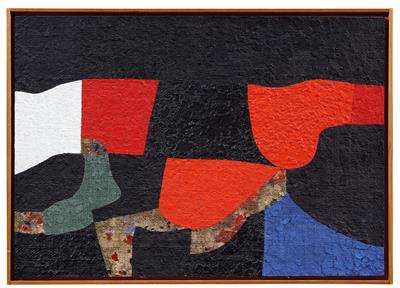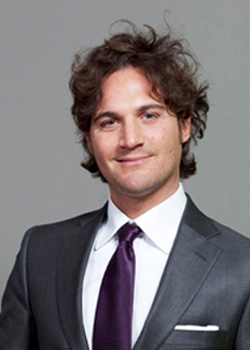Alberto Burri *

(Citta di Castello/Perugia 1915–1995 Nice)
Untitled, 1947/1988, signed, dated and inscribed on the reverse, acrylic and vinavil on canvas applied on board, in artist’s frame, 44 x 61.5 cm
Provenance:
European Private Collection
Literature:
M. Vallora, Confronti, sintonie e dissonanze, in Marca-Relli, l’amico americano. Sinotnie e dissonanze con Afro e Burri, Ed. Galeria d’Arte Niccoli, Parma 2002, p. 263 with ill.
B. Corà, Burri. Catalogo generale, Vol. III, Pittura, 1979 – 1994, Fondazione Palazzo Albizzini Collezione Burri, Città di Castello 2015, p. 324 with ill. no. 2151 (the work is published with wrong dimensions. As per communication by Fondazione Palazzo Albizzini Collezione Burri, they will be updated in the next edition of the catalogue)
Note:
The double dating of the work (1947/1988) is due to the fact the artist used a work dated 1947 (brownish areas) as support for realizing the actual work.
Along with Lucio Fontana, Alberto Burri influenced Italy’s post-war art like no one else. Idiosyncratic as his art may seem, this artist born in Umbria in 1915 is considered one of the pioneers of Arte Povera. His influence went far beyond Italy’s borders. Famous painters, such as Cy Twombly and Robert Rauschenberg, would visit him in his studio. The Guggenheim Museum in New York also became aware of him early on, and exhibited his collages and material assemblages in 1954.
Burri participated in the Biennale and Documenta multiple times. In 1981, he created one of the most powerful combinations of monument and landscape art by covering the ruins of the Sicilian village of Gibellina, destroyed by an earthquake, with a thick layer of concrete. The old streets remained visible as walkable ‘incisions’ reminiscent of the cracks in some of his material paintings.
Despite experimental techniques, Burri’s stylistic idiom appears profoundly classical, and is rooted in his experience of the War. Originally trained as a physician, Burri served as a military doctor. He began processing his traumas as a prisoner of war in Texas, USA, where he had been transferred by the British in 1943.
At that time, he exchanged his surgical instruments for painting tools forever. His pictorial material – including burlap sacks from aid supplies in his first years, subsequently also veneer and plastic foil - was ripped, stitched, and burnt. Burri celebrates the sacred nature of matter by letting it mean no more than itself. It is autometaphoric and therefore the search for allegories is pointless. Instead, the focus is on formal, plastic and chromatic qualities. In Burri’s works, matter is already form per se. Form that is repeated within his work – “the first picture is like the last one” – to express the continuity of an art project reflective of the unified vision the artist. A kind of diachrony emerges as the works become continuous promulgations of the past, but at the same time draw from fertile intuitions of the future. Burri’s style is therefore “a method capable of summing up past experiences but also anticipations: almost an organic flow that through different ‘skins’ proposes the same theme, the same determination to manifest itself as a necessary event.”
(G. Serafini, Burri, Dossier di “Art e Dossier”, Florence 1991, p. 44)
In order not to obstruct the view of the material essence and to avoid the superfluous, Burri reduces his colour palette to earth tones. Only red is used as signal colour: red paint leaks through the cracks, holes in molten plastic look like wounds. Sometimes he curves the surfaces of his paintings with metal bars on the reverse. The artist deliberately destroys when he experiments with fire, charring the wood and melting plastic. In the process, destruction loses its negative, annihilating character, for which his work is the best proof.
Esperto: Alessandro Rizzi
 Alessandro Rizzi
Alessandro Rizzi
+39-02-303 52 41
alessandro.rizzi@dorotheum.it
25.11.2020 - 16:00
- Prezzo realizzato: **
-
EUR 174.100,-
- Stima:
-
EUR 140.000,- a EUR 180.000,-
Alberto Burri *
(Citta di Castello/Perugia 1915–1995 Nice)
Untitled, 1947/1988, signed, dated and inscribed on the reverse, acrylic and vinavil on canvas applied on board, in artist’s frame, 44 x 61.5 cm
Provenance:
European Private Collection
Literature:
M. Vallora, Confronti, sintonie e dissonanze, in Marca-Relli, l’amico americano. Sinotnie e dissonanze con Afro e Burri, Ed. Galeria d’Arte Niccoli, Parma 2002, p. 263 with ill.
B. Corà, Burri. Catalogo generale, Vol. III, Pittura, 1979 – 1994, Fondazione Palazzo Albizzini Collezione Burri, Città di Castello 2015, p. 324 with ill. no. 2151 (the work is published with wrong dimensions. As per communication by Fondazione Palazzo Albizzini Collezione Burri, they will be updated in the next edition of the catalogue)
Note:
The double dating of the work (1947/1988) is due to the fact the artist used a work dated 1947 (brownish areas) as support for realizing the actual work.
Along with Lucio Fontana, Alberto Burri influenced Italy’s post-war art like no one else. Idiosyncratic as his art may seem, this artist born in Umbria in 1915 is considered one of the pioneers of Arte Povera. His influence went far beyond Italy’s borders. Famous painters, such as Cy Twombly and Robert Rauschenberg, would visit him in his studio. The Guggenheim Museum in New York also became aware of him early on, and exhibited his collages and material assemblages in 1954.
Burri participated in the Biennale and Documenta multiple times. In 1981, he created one of the most powerful combinations of monument and landscape art by covering the ruins of the Sicilian village of Gibellina, destroyed by an earthquake, with a thick layer of concrete. The old streets remained visible as walkable ‘incisions’ reminiscent of the cracks in some of his material paintings.
Despite experimental techniques, Burri’s stylistic idiom appears profoundly classical, and is rooted in his experience of the War. Originally trained as a physician, Burri served as a military doctor. He began processing his traumas as a prisoner of war in Texas, USA, where he had been transferred by the British in 1943.
At that time, he exchanged his surgical instruments for painting tools forever. His pictorial material – including burlap sacks from aid supplies in his first years, subsequently also veneer and plastic foil - was ripped, stitched, and burnt. Burri celebrates the sacred nature of matter by letting it mean no more than itself. It is autometaphoric and therefore the search for allegories is pointless. Instead, the focus is on formal, plastic and chromatic qualities. In Burri’s works, matter is already form per se. Form that is repeated within his work – “the first picture is like the last one” – to express the continuity of an art project reflective of the unified vision the artist. A kind of diachrony emerges as the works become continuous promulgations of the past, but at the same time draw from fertile intuitions of the future. Burri’s style is therefore “a method capable of summing up past experiences but also anticipations: almost an organic flow that through different ‘skins’ proposes the same theme, the same determination to manifest itself as a necessary event.”
(G. Serafini, Burri, Dossier di “Art e Dossier”, Florence 1991, p. 44)
In order not to obstruct the view of the material essence and to avoid the superfluous, Burri reduces his colour palette to earth tones. Only red is used as signal colour: red paint leaks through the cracks, holes in molten plastic look like wounds. Sometimes he curves the surfaces of his paintings with metal bars on the reverse. The artist deliberately destroys when he experiments with fire, charring the wood and melting plastic. In the process, destruction loses its negative, annihilating character, for which his work is the best proof.
Esperto: Alessandro Rizzi
 Alessandro Rizzi
Alessandro Rizzi
+39-02-303 52 41
alessandro.rizzi@dorotheum.it
|
Hotline dell'acquirente
lun-ven: 10.00 - 17.00
kundendienst@dorotheum.at +43 1 515 60 200 |
| Asta: | Arte contemporanea I |
| Tipo d'asta: | Asta in sala con Live Bidding |
| Data: | 25.11.2020 - 16:00 |
| Luogo dell'asta: | Wien | Palais Dorotheum |
| Esposizione: | online |
** Prezzo d’acquisto comprensivo dei diritti d’asta acquirente e IVA
Non è più possibile effettuare un ordine di acquisto su Internet. L'asta è in preparazione o è già stata eseguita.
